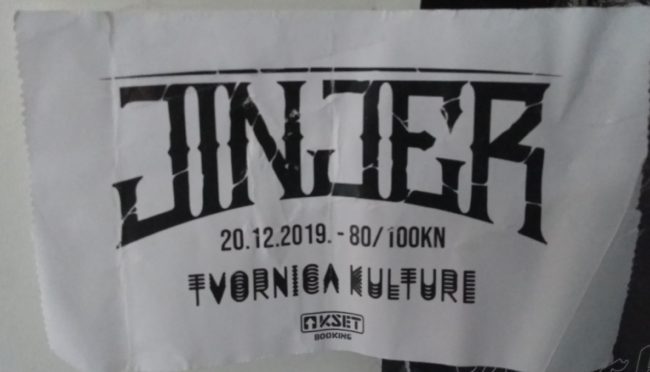Female emancipation in metal – too late?
In 1979, Motörhead released the song ‘Too Late Too Late’ as a b-side to the ‘Overkill’ single. If we take the song title as a question, it seems to fit the history of female emancipation in heavy metal culture. As already Deena Weinstein stated in her pivotal cultural sociology of metal,1 metal culture has been imbued with conservative gender stereotypes right from the start. Nonetheless, metal itself as well as metal studies have diversified in terms of gender roles since.2
In this blog post, I want to take up these reflections on female gender roles in metal and discuss them under the auspices of the theoretical notion of ‘norm-related sonic knowledge’. This notion is at the heart of the research project on law-related phenomena in metal cultural history I am leading in the three coming years. In this project, we want to research how law and law-related phenonema contributed to the specific scene-building process in Graz and Styria from the 1980s to the present.
In one of the two peer-reviews of the research proposal, the reviewer mentioned critically that gender roles are an important matter in this project and should be researched more prominently. Undoubtedly, the reviewer was insofar right as law is intrinsically connected to the normative spheres of metalness and thus touches upon gender normativities. However, since this is the first research on this topic at all, we cannot deliver a ‘full’ history of all facets. Perhaps, systematically, it would make sense thinking of such more specifical research after the basic research on this scene is done. In this post, I will raise some points that could lead into this direction.
Jinjer in Zagreb
Last Friday, I had the opportunity to see the Ukrainian band Jinjer live in the venue of Tvornica Kulture in Zagreb, Croatia. The experience of a Jinjer concert is a great occasion to discuss this topic, because the band in highly interestingly ways breaks up usual gender standards in their music. Their music can be described as a mixture of death metal, djent and groove metal. Their musical language is characterized by ‘bouncing’ guitar riffs (that reminded me of Rage Against The Machine’s Tom Morello) and, most of all, the versatile vocals by singer Tatiana Shmailyuk .
It is this vocal style and the singer’s on stage performance that is worth taking a closer look. Being such a versatile vocalist, Shmailyuk performs both harsh guttural parts and clean melodic singing parts. The result is a combination of very aggressive parts and mellow melodic parts, usually within one individual song. Hence, reminding of black metal artisy Myrkur, the singer can play both roles of the ‘tender’ woman and of the aggressive female. These two short clips I recorded at the concert illustrate the band’s musical language:
What I witnessed at the venue in Zagreb in front of an highly energetic, sometimes almost rowdily mosh-pitting crowd also was a musical perfomance of gender roles in metal. In her vocals, the singer delivered both aggression and softness. In this specific historical event of a concert, repeated during a tour cycle on an almost daily base, Jinjer broke up the normativities of metal gender roles and created something new. I do not know whether it was this sheer overwhelming experience of an emotional rollercoaster that dynamized the crowd’s behaviours in such dramatic ways.
The norm-related sonic knowledge of gender in metal
In our project, we will use the mentioned concept of norm-related sonic knowledge as an analytical description of the longue durée dimension of sense-making in metal by law-related phenomena and topics. The notion describes how such phenomena were used in metal culture to constitute the normative sphere of the regional scene in Graz and Styria.
Already applied to the event of Jinjer’s performance in Zagreb, the notion leads to so far not asked questions on gender roles. If we see the history of female metalness as a long, diversifying and ambiguous development of normative ‘gender laws’ over almost fifty years since Black Sabbath took the stage, then this concert in late 2019 was a play in this history and with this history.
Jinjer took some of the key norms (conservative female gender roles), broke them into pieces and re-assembled them into a new set of rules that probably could contribute to new, more progressive ‘scene laws’ in the future. If we think of this recomposition as a deeply cultural-historical act refering to five decades of women in metal, this seems to come late but not too late – but only so if the culture itself and also metal studies seriously keep up engaging with ‘difficult’ topics such as racism, misogyny or nazism.
D. Weinstein, Heavy Metal: The Music and its Culture, Boulder, CO: Da Capo Press, 2000. ↩
A. Digioia & L. Helfrich, ‘”I’m sorry, but it’s true, you’re bringin’ on the heartache”: The antiquated methodology of Deena Weinstein’, in Metal Music Studies Volume 4, Number 2, 1 June 2018, pp. 365-374; also, see more globally: H. Savigny & J. Schaap, ‘Putting the “studies” back into metal music studiesPutting the ‘studies’ back into metal music studies’, in Metal Music Studies Volume 4, Number 3, 1 September 2018, pp. 549-557. ↩



